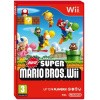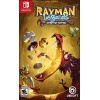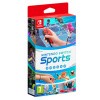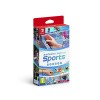Feature: 18 Best Credits Sequences And Loading Screens That Let You Do Stuff
Credits and loading screens within video games generally aren’t particularly interesting for players. Credits sequences are a great way to take note of the amazing developers that make our favourite games, but they’re more often than not devoid of any interactive element. Loading screens, meanwhile, are just that: loading screens. They’re mostly static images or looping animations that do nothing but test your patience while you wait to dive into the game. A tool tip or some lore nuggets might help pass the time, but otherwise you’re just twiddling your thumbs.
Sometimes, though, minigames and interactive elements are peppered into loading screens and rolling credits that elevate what might otherwise be a drag to a whole other level. It took a while to come to full fruition, too; while credits sequences have played around with interactive elements for years at this point, developers were somewhat limited to what they could do with loading screens thanks to a patent filed in 1998 by Namco for “auxiliary games”, effectively giving the company exclusive rights to create minigames within loading screens.
The patent thankfully expired in November 2015, giving developers total freedom to play around with loading screens to their hearts’ content. Granted, stumbling across a worthwhile minigame during loading screens or credits sequences even to this day is still a frustrating rarity, so we’ve gone ahead and compiled some of our favourites from across the years.
SPOILER ALERT: Please note that the videos featured here may contain the end cutscenes prior to the credits sequence. Keep this in mind If you’re concerned about avoiding spoilers.
With that said, on with the show! Let’s start off with some ending credits that tried things a little bit differently…
Breaking blocks has been a staple in Mario games since the very beginning, but New Super Mario Bros. Wii took the idea to the extreme with its credits sequence.
The entire line up of developers is displayed in block form and you’re tasked with breaking as much of it as you can before it scrolls up and out of sight. Even better, you can enlist your friends if playing in co-op mode for some truly chaotic fun. Breaking multiple blocks in a row bags you with some bonus coins, so it’s definitely worth taking part in.
Please note that some external links on this page are affiliate links, which means if you click them and make a purchase we may receive a small percentage of the sale. Please read our FTC Disclosure for more information.
Much like New Super Mario Bros. Wii, both Rayman Origins and Rayman Legends see you smashing up the credits as it scrolls up the screen.
It’s arguably more intuitive than Nintendo’s effort too, with Rayman boasting a more diverse move set; it feels like you’re effortlessly breaking through glass, it’s so satisfying. If we absolutely had to complain though, we reckon the credits go on a touch too long. It’s good, but it’s not that good.
Most of the Super Smash Bros. games feature some sort of interactive credits sequence; in fact, almost all of them involve shooting at the names as they fly by the screen. The sequence from Super Smash Bros. Melee holds a special place in our hearts, but the one from Super Smash Bros. Ultimate is arguably the most fun of the bunch.
Styled like a classic shmup, you’ll be flying vertically, horizontally, and diagonally as you blast away at the various names passing by. You’ll even come across bombs that take out multiple names in one go.
Super Smash Bros. for Wii U went in a different direction to the rest of the series, with the credits sequence tasking you with smashing up a load of names with your chosen character as they scroll across the screen. Doing so slowly reveals a special picture of your character, so there’s plenty of incentive to complete this sequence with the entire fighting roster.
You can go through this sequence co-operatively, too, as demonstrated in the embedded video above (sorry for all the “pikas“).
Devil May Cry 3 is all about excess and having fun. Capcom knew this all too well — particularly after the poor reception to Devil May Cry 2 — so saw fit to extend the third outing’s gameplay well into the end credits sequence.
Rather than simply fade to black and have a bunch of names scroll up the screen, Dante and Lady engage in one final battle accompanied by a badass metal soundtrack. It’s the perfect end to one of the greatest hack ‘n’ slash games in recent memory.
It’s pretty clear that PlatinumGames took a look at what Devil May Cry 3 did with its credits sequence and thought “hey, let’s just do that!“. It’s a fair decision, and to give the dev some credit [Badoom-tish – Ed], it mixed things up a bit in Bayonetta by introducing short playable sequences involving a diverse set of enemies, from standard enemies right up to huge, hulking beasts.
Eventually, the credits eases into a more traditional approach, but the gameplay segments are incredibly fun while they last.
Punch Out!! for the Wii took its central premise and ran with it when the credits rolled, tasking players with “punching” any names that looked a bit odd during the end sequence. See a name that’s spelt wrong, or a letter that’s upside down? Give the name a good whack and it’ll turn green, rewarding you with points in the process.
It’s a fun twist on the gameplay featured in games like New Super Mario Bros. Wii and Rayman Legends in that it requires you to think a bit more about what you’re hitting.
What a glorious game this is, eh? Super Mario Galaxy 2 displayed a bunch of dioramas during its credits sequence, giving players an opportunity to grab as many stars as possible during short periods before the next diorama pops up.
Interestingly, if you’re able to turn into Bee Mario during this sequence, it’s actually possible to die by flying off the screen. Doing so will result in the usual game over screen, but the credits will continue rolling against a pitch black screen until the end. Was this intentional? Possibly not!
The majority of Undertale‘s credits sequence is pretty standard: scrolling names with the odd animated scene here and there. When you get to the ‘Special Thanks’ section, however, it’s an entirely different matter. Here, you’ll take control of the heart and will need to avoid groups of names as they come hurtling toward you in various different patterns.
You have infinite health during this section, so it’s not possible to “lose”, as such, but it’s still an incredibly fun sequence that will really test your gameplay skills.
We’ve already spoken about this one, but Nintendo Switch Sports includes a great little minigame within its credits that requires you to hit a tennis ball back and forth against the names while they’re scrolling up to the left.
Doing so 50 times in a row will bag you with the unique ‘Staffer’ title, so it’s worth doing. You know, if you like titles.
On the next page we move away from credits to the loading screens that tried their very best to make you forget you’re looking at a loading screen…











